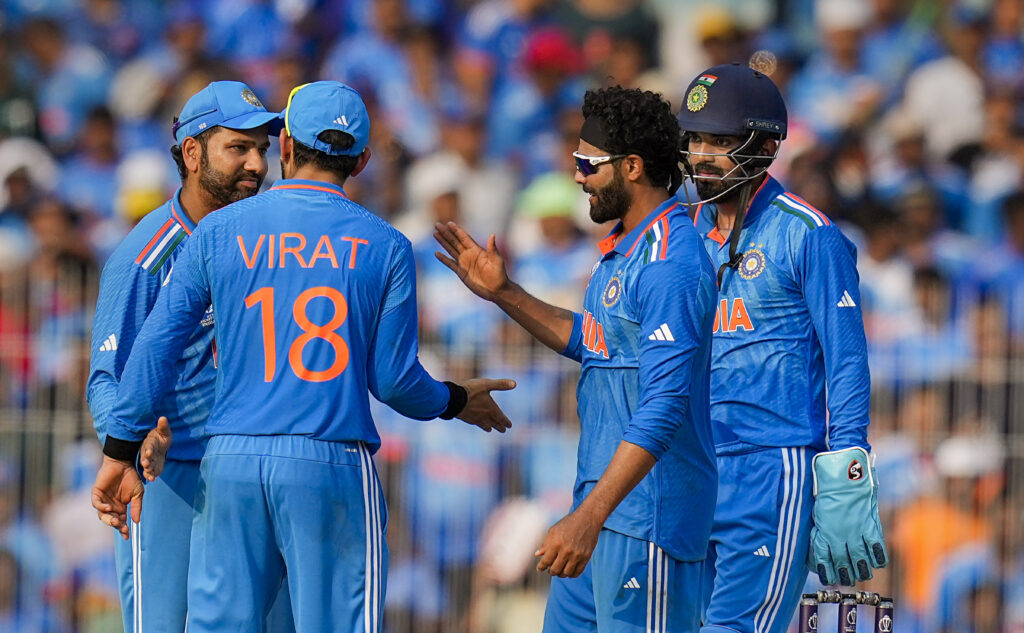
Just a mere glance at the scorecard of the Australia-India World Cup game in Chennai would show that all six bowlers employed by the home side ended up sharing the wickets. Even Hardik Pandya, who went for a few in his opening spell, returned to wrap up the innings. The central narrative in India snuffing out Australia for just 199 was the all-round strength in the bowling attack. Wrist-spin, finger spin, a little bit of pace and hit-the-deck skills, three-quarter-seam and a touch of swing – India had the raw materials and, if needed, something in reserve too.
For a while over the past year, the spark in the bowling line-up had been missing. It was obvious that they missed Jasprit Bumrah, their pace spearhead. Laid low by a back injury last year, he had to undergo a difficult surgery. Since his return to the side for the limited-overs series against Ireland, the Indian attack has found the apex of its five-man pentagon.
Bumrah’s greatness is that he can wear different hats according to the conditions. With ball in hand, he transforms into an Englishman in England, dons the Australian floppy hat in Australia, and a Sri Lankan on the teardrop-shaped island. For the umpteenth time, he showcased that kind of versatility by keeping the runs down and taking two wickets on a Chennai wicket that stayed slow and low.
In his opening spell in Chennai, he was prepared to bowl in the corridor of uncertainty and find some nifty movement. The reward for that persistence was Mitchell Marsh’s wicket. Subsequently, in the slog, Bumrah tweaked his strategy by targeting the stumps – only four out of his 24 deliveries were not zoomed in at the three sticks.
Mohammed Siraj has proved to be the ideal foil for Bumrah. In ODIs, Siraj also has the ability to step up and take over the mantle of being leader of the pack hunters. Incidentally, he has taken more wickets than any other bowler in the Powerplay in the 50-over format since the last World Cup. In the final of the 2023 Asia Cup, Siraj also dismantled Sri Lanka’s batting unit with swing and movement off the deck via the three-quarter-seam ball.
In Chennai, with the spinners ruling the roost, Siraj quietly slipped into the role of being one of the ancillary parts. He is also adept at bowling in the slog overs. At the moment, there is no asterisk attached to Siraj’s bowling in ODIs.
Meanwhile, Kuldeep Yadav will, in all likelihood, be cornerstone of the spin department in the ongoing World Cup. Not long ago, Kuldeep was lost in the wilderness, but with the help of Kapil Pandey, his coach, he worked on various aspects of his game – imparting more revs, increasing the pace on the ball and also improving his control.
“From the time of Covid-19, we were working hard,” Pandey had told RevSportz in a recent interview. “The ball was coming out slow, especially in T20s. One has to bowl faster, one has to add more revs on the ball. As per the changing times, changes have to be done in bowling. If you look at the seam of the delivery, we have made changes to it. So that one doesn’t pick it, and if you bowl with good speed in internationals, it becomes a bit difficult to pick it. He is mixing it up (lengths and variations) very well.”
All those hard yards in training have translated into wickets. Kuldeep has taken 47 ODI wickets at an average of 19.23 since the start of 2022.
Ravi Ashwin, who was recalled to the Indian side after Axar Patel couldn’t recover from his hamstring injury, has enough experience and skill to survive in the 50-over format. It is true that modern-day ODI cricket doesn’t offer much for finger spinners as two white Kookaburra balls are used. But Ashwin is someone who conducts different experiments in his own laboratory in order to develop new weapons.
For a moment, travel back to the second ODI against Australia in Indore last month. In very good conditions for batting, Ashwin employed the reverse carrom ball – flicked underneath – to pose searching questions to the Australian batters.
Ravindra Jadeja, his long-term spin colleague, starred for India in this opening game. The conditions in Chennai were tailor-made for him. He is renowned for his unremitting control and side-spin, and he blended both those skills to run through the cream of the Australian middle order and pick up three wickets.
Jadeja’s bowling is based on a simple mantra – zoom most of the deliveries on and around a good-length area and wait for natural variation off the pitch to do the rest. So, a few of the deliveries could be straighter ones, and then one could turn considerably. This simple but deadly template proved to be Steve Smith’s downfall in Chennai.
On the flip side, despite his bowling prowess in certain conditions, there are still question marks over whether Jadeja can land lusty blows at the crucial No.7 slot.
In addition to those who played against Australia, India also have Mohammed Shami and Shardul Thakur. Such is Shami’s ability to bowl with an upright seam that you can almost imagine him waking up at 2AM, and still managing to hit the seam time and again.
There was a bit of concern surrounding Hardik’s tendency to bowl floaty stuff at the start of the Australia game, but he is undoubtedly a vital cog as he balances the side with his all-round skills.
The bigger question for the Indian think-tank is whether to pick Shardul as he adds more depth to the batting unit. He has, however, averaged just 9.55 with the bat in his last 20 ODIs. So, for the time being, India would likely opt for Bumrah, Siraj, Ashwin/Shami, Kuldeep, Jadeja and Hardik – a bowling attack that passed its first difficult test with flying colours.




